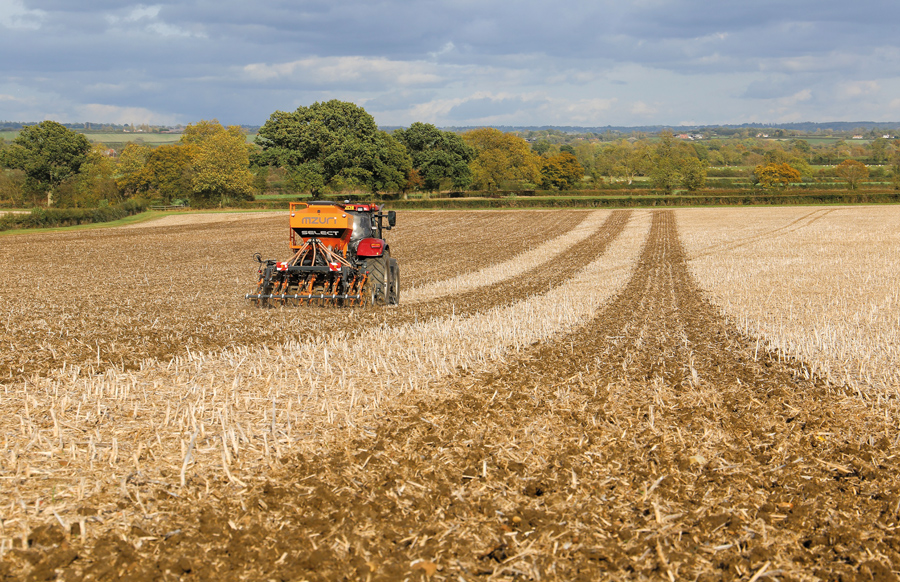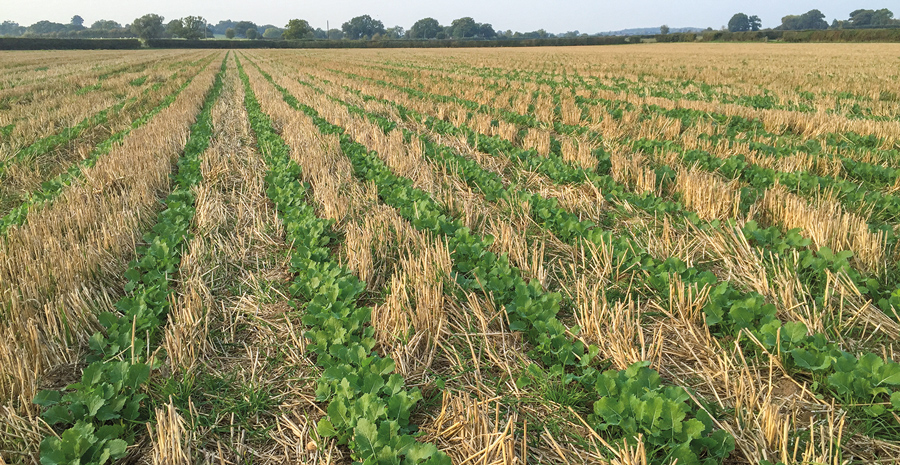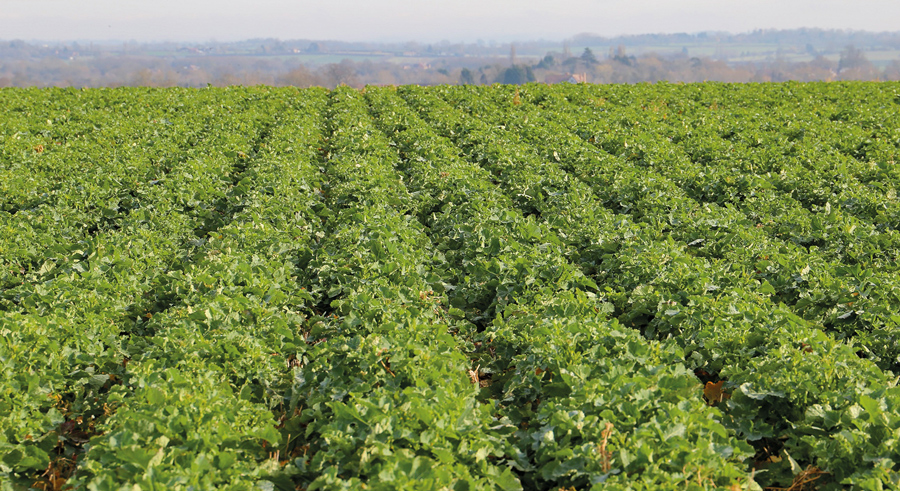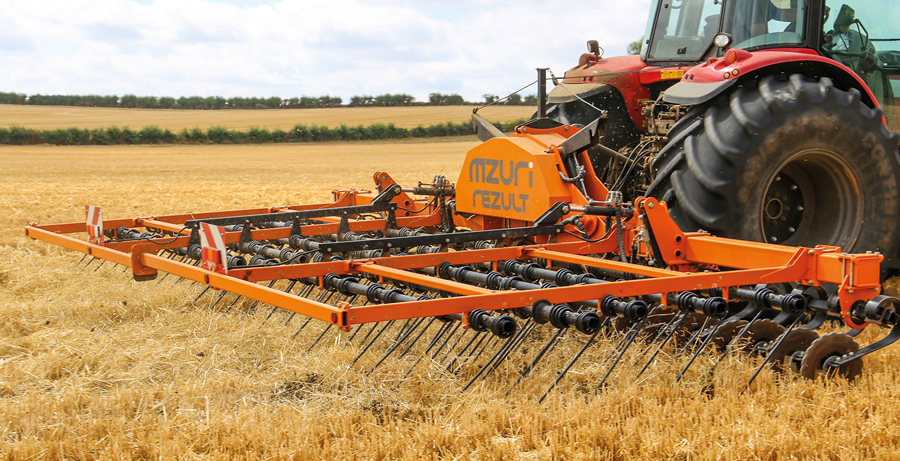Integrated approach to crop establishment gets best out of Mzuri strip-till drill
2nd August 2019
With pressures like slugs, black-grass and flea beetle to contend with, everyone knows getting a crop up and away in the autumn is critical, but not everyone knows this can be achieved in one-pass, straight behind the combine.

With pressures like slugs, black-grass and flea beetle to contend with, everyone knows getting a crop up and away in the autumn is critical, but not everyone knows this can be achieved in one-pass, straight behind the combine.
British manufacturer Mzuri has been championing just that, a strip tillage system that achieves quick, even establishment in a range of soil types – with none of the typical drawbacks of direct drilling.
Tackling many of the common pitfalls of direct establishment, the Mzuri system centres around two key pieces of equipment – the one-pass Pro-Til strip-till drill and the Rezult stubble rake. Designed and manufactured in the UK, the Mzuri system has been tried and tested on the company’s trial farm in Worcestershire and has since seen excellent uptake across Britain, Europe and even as far afield as New Zealand and parts of Africa. The manufacturer puts the system’s success down to its versatility and ability to establish a wide range of crops, in different soil types.
Strength to strength
Mzuri’s trial farm manager, Ben Knight experienced this firsthand at Springfield Farm where he manages the manufacturer’s trials alongside the commercial farming enterprise. “Since converting to strip tillage, crop establishment, Springfield Farm has gone from strength to strength,” he says.
“By creating a shattering effect in a targeted zone the Pro-Til produces a fine tilth vital for good seed-to-soil contact, with nutrition and moisture easily accessible giving crops the optimum environment to germinate quickly and evenly.”
Designed to clear previous crop residue from the seeding zone, the Pro-Til’s leading leg produces a clean strip of friable soil while mineralising nutrients. Ben Knight explains; “The action of the Pro-Til’s front leg creates the perfect nursery seedbed in which to place the seed.
“It’s important to ensure seed is placed into the centre of the tilled strip and at a consistent depth. The Pro-Til with its pivoting coulters, all individually hydraulically pressurised, follow the contours of the field and remain in-line with the leading legs even around tight headlands which means we achieve accurate seed placement across the whole field,” he explains.

Even establishment of oilseed rape gives the crop the best chance against pests.
“In one pass, the drill reconsolidates the soil firmly around the seed in two stages, improving seed-to-soil contact further and providing protection from pests.
“Another key component of the Mzuri system that makes it so successful on this farm and many others, is its ability to promote even establishment of crops like oilseed rape. In situations where flea beetle are present, the even emergence of the plants means predation is spread evenly, causing less feeding pressure than when plants emerge one by one through uneven seeding depth. The crop is also in a much better condition to grow away from any damage quickly thanks to moisture retention and access to mineralised nitrogen at drilling.”
Further generating rapid, early growth, the Mzuri system advocates band placing fertiliser below the seeding zone to improve efficacy and availability. Mr Knight has found that by applying fertiliser with the Pro-Til’s leading leg below the seed, there is less reliance on rainfall to break down the product, instead it’s placed directly into moisture, right where the new plants are going to need it.”
Targeted cultivation
Ben Knight suggests that modern agricultural practices have had an increasingly detrimental effect on soil health from continuous over cultivation and by not replenishing lost nutrients.
“Soils high in organic matter are more resilient to machinery traffic and are better able to absorb and retain soil moisture. High levels of organic matter can lead to acidification of the soil over time but the Mzuri system gives us the ability to achieve both high organic matter levels and aerated soils.
“By only cultivating in bands we can clear crop residue from the seeding area, allow oxygen into the profile, while leaving the strips between undisturbed, thereby retaining their nutrition and structure for later in the season,” he adds.
It is this targeted tillage that the manufacturer attributes the Pro-Til’s success in improving degraded soils as part of the wider system. By concentrating the cultivation within carefully placed bands, it’s possible to achieve all the benefits of a cultivated soil while also retaining the structure needed for root development and the weight resistance that would more often be associated with a min-till system.

The natural architecture of oilseed rape suits the wider 66cm rows.
Wider rotation
As part of an integrated approach to soil health, Mzuri encourages its users to adopt a wider rotation, including cover crops where possible, prior to spring cropping. At Springfield Farm, Ben Knight has been incorporating cover crops into his rotation for a number of years and has seen the benefits stack up.
“By providing the perfect environment for crops to thrive, we benefit from the work the crop’s roots do throughout the soil profile. We use cover crops including tillage radish, oats and vetches and try to have a growing plant in the ground for as much of the year as possible. Not only does this harvest as much sunlight as it can, but it also means there is a root structure that penetrates the lower levels of the soil profile which allows water to infiltrate, supports biodiversity and binds the soil aggregates together – particularly important over winter.”
A common establishment pitfall can be a lack of moisture at drilling, either due to prior heavy cultivations or as a result of a rain deficit. Users of the Mzuri strip tillage system will know the manufacturer suggests leaving crop residue on the surface, creating a protective layer of ‘thatch’, preventing moisture loss.
“Moisture at planting is key to quick establishment but also to support the crop going forward,” continues Mr Knight. “Managing our crop residue has been one of the single biggest factors in improving our cropping, particularly oilseed rape where early moisture can be critical.
“We chop the straw behind the combine and leave the stubble long. Not only does this have the effect of encouraging the seedlings on, but the layer of thatch retains moisture. We haven’t seen an increase in slugs with this method or had a problem with crops breaking through the layer.
“And the long stubble helps to keep pigeons off which is always a bonus.”
In situations where the straw must be taken off, particularly in mixed enterprises, Mzuri suggests that returning muck can be a good alternative. Left on the surface, deep working earthworms will drag the matter down where the soil biology can degrade it effectively, releasing nutrients for the growing crop.
Mr Knight has found that leaving the previous crop residue on the surface has taken the risk out of spring cropping. “The only thing predictable about weather patterns is their unpredictability, so establishing a spring crop can be seen as too high risk for many to view as a viable option.
“Since expanding our rotation, we have required more spring crops. By supporting a soil structure that can let water infiltrate when wet and a protective layer of residue to retain moisture when it comes dry, we are effectively taking the risk out of our spring crops. The direct nature of the drill also means we can get seed in and established quickly and come spring or winter, crops are thriving as a result.”
Row widths
The Pro-Til boasts two row width options of 33 and 66cm. Mzuri says that 33cm proves popular with cereal establishment whereas the 66cm wide row suits oilseed rape.
“Part of the system is to maximise the amount of light into the lower levels of the crop,” says Mr Knight. “The leaf of the plant is a natural solar panel and needs space to take in as much light as possible throughout the day.
“The band placement of seed, especially cereals, allows greater light interception through the depth of the canopy. While the flag leaf is considered the most vital for yield for a wheat plant, the lower leaves continue to aid photosynthesis and contribute sugars to ears and grain.”
Single and double coulter options can be used to adjust the spacings between rows further, allowing for even greater flexibility.
Wider rows have also shown less disease throughout the season, explains Mr Knight. “Increasing the distance between crop rows not only supports higher yields but also aids the movement of air throughout the plants helping to keep the lower leaves and stem bases well ventilated which can reduce the incidence of mildew and eyespot which occur more frequently in humid conditions.
“However, increasing the spacing between plants goes beyond light interception and micro climates. In OSR, reducing interplant competition means that the plants have space to branch earlier without bolting for sunlight. This process helps to increase yield through a reduction in apical dominance and a more stable canopy because much of the branching occurs earlier and reducing the stress of a tall, leggy stem.
“Trials at Springfield Farm have shown that when compared with standard 33cm rows, our OSR drilled on 66cm row spacing is significantly less likely to lodge and also achieves an uplift in yield. By managing light interception, we are able to produce strong, healthy plants with more pods and carry them through to harvest.”
Pest and weed pressure
The Mzuri strip tillage system isn’t complete without the Rezult stubble rake, points out the company. A staple on the manufacturer’s trial farm, the implement is a major tool in Mr Knight’s arsenal against slugs and weed pressure.
“By using the rake as a cultural control method, we are actively reducing slug populations ahead of sowing by breaking the life cycle at the first stage. The heavy-duty tines destroy slug habitats while bringing eggs to the surface where they are exposed and baked in the heat of the day.
“By not inverting the soil, we keep any weed burden on the surface rather than mixing it through the profile where we would likely experience multiple emergences. Using the rake fitted with front discs we can generate sufficient tilth to achieve a flush of weeds which can be effectively managed in one go with the sprayer.”

The Rezult rake is a useful tool for tackling slugs and preparing stale seedbeds.
